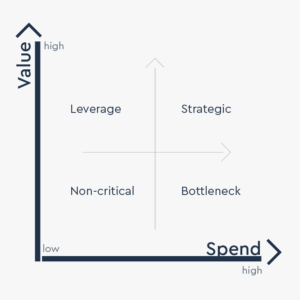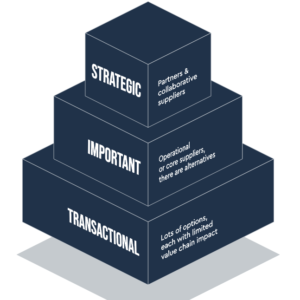What is Supplier Segmentation?
Supplier segmentation is the process of categorizing suppliers into various categories in order to allocate limited resources to manage them efficiently. It’s a vital component of supplier relationship management strategy.
Benefits of Supplier Segmentation.
- Segmentation showcases the value generated from suppliers, helping businesses determine which vendors are most appropriate for potential collaborative partnerships or increased investment.
- An engagement plan based on segmentation helps optimize the time and resources spent on supplier management. This helps to clearly focus energy on customer-oriented outcomes.
- Segmentation can highlight which relationships should be leveraged to advance innovation.
- A supplier’s performance is closely linked with the level of communication and engagement it’s receiving from the buyer. Prioritizing suppliers and giving them a better understanding of strategic objectives goes a long way to enhance overall service levels.
Factors that Influence Supplier Segmentation.
The approach is influenced by your particular industry and the type of business you run. Take into account the following:
- The entire amount of money spent each year and the amount of money that will be spent in the future.
- The complexity of the acquired service or goods.
- The value that a supplier adds to a company.
- How many business units purchase from your supplier?
- Total number of active suppliers in the database.
- Risks associated with suppliers, such as non-delivery and financial strain.
The fundamental goal of supplier segmentation is to determine where you should concentrate your efforts in order to maximize the value of your supplier relationships. There is no one-size-fits-all solution to supplier segmentation; choose what works best for you.
Ways to Segment Suppliers
The matrix approach
The volume of spend is often the starting point of supplier segmentation. When plotted alongside value, the result is a framework for splitting your supplier base into different segments. Value is defined as how important a supplier is in terms of business continuity.This classification method can be customized to provide more detailed sub-groups within each quadrant, like so:

The pyramid approach
A pyramid is a different way of viewing the supplier database using the same priorities: strategic, important, and transactional.A supplier pyramid typically has 3-4 tiers, depending on whether partners are split into their own group at the top of the pyramid or grouped in the strategic category.
As you move up the pyramid, the value of suppliers increases and the number of suppliers in that category decreases.

Best Practices in Supplier Segmentation.
- Use the 80/20 rule. Concentrate on the top 80% of spending, which often equals 20% of the supplier database.
- When segmenting major suppliers, consider both subjective and objective input.
- Distribute the selected segmentation model to internal users to address all touchpoints with a supplier model.
- Communicate to your major suppliers about innovation and continual improvement.
Developing a segmentation strategy can help businesses stay ahead of the curve and maintain resilience in the face of emerging challenges. But it also helps companies stand out against competitors in regard to innovation, revenue, and profitability.
Source:
ventureconnections.info



